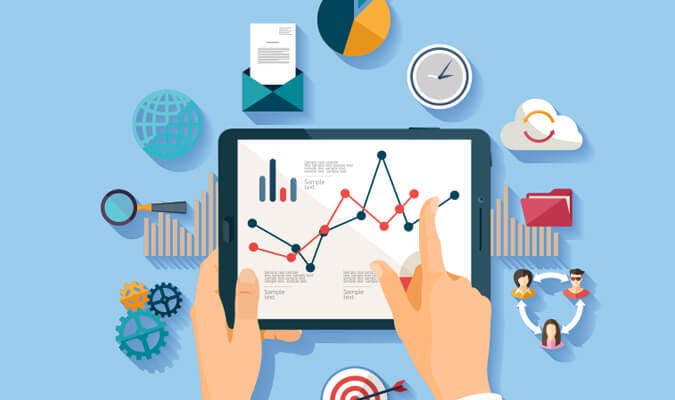Introduction
Customer expectations have risen to new heights, and industry competition is intensifying, putting organizations under constant pressure to enhance efficiency and outcomes. At the same time, the volume and variety of data available have exploded; firms may now get data from across their organization's internal sources as well as from external industry sources. Access to this growing pool of structure and unstructured data sources gives companies a huge competitive advantage and allows them to do in-depth market research for company business units and/or business disciplines across the lines of business, giving them valuable insight into current sales patterns from the sales team, crucial company continuous improvements, and market gaps to exploit. Several companies have already embraced different approaches to data management and processing of big data using cloud-based services, parallel or distributed computing, business intelligence software, etc.
As a result, analytics has emerged as one of the most significant tools available to a company. The advantages of combining data and analytics are evident. Companies may use data to save costs, and service levels, rethink processes, drive market strategy, and market performance, create competitive differentiators, and, perhaps most importantly, provide an extraordinary and personalized customer experience.
Most business leaders today recognize the importance of data to their company. According to a recent IDG study, 47% of chief information officers (CIOs) expect their expenditure on analytics and business intelligence to expand the most over the next 12 months. Even though analytics can deliver real-time insights across multiple company functions and improve overall decision-making/business issues to produce better results, many businesses fail to do so.
What is Business Analytics?
Advertisment

Business analytics is the process of gathering data, measuring business performance, and producing valuable conclusions that can help companies make informed strategic decisions on the future of the business, through the use of various statistical methods and techniques. Business Analytics assumes that given a sufficient set of analytics capabilities exist within an organization, the existence of these capabilities will result in the generation of organizational value and competitive advantage. For example, customer intelligence is one of the factors of competitive advantage organizations can derive from their customer relationship management system (CRM) using business analytics.
What is Competitive Advantage?

Competitive advantage is what distinguishes a company's goods or services from all other options available to a customer. It refers to the elements that enable a company to manufacture goods or services more efficiently or at a lower cost than its competitors. This may result in the company gaining a large market share. These elements enable the producing unit to earn higher sales or higher margins than its competitors. A range of elements contributes to competitive advantages, including cost structure, branding, product quality, distribution network, intellectual property, and customer service improving the company's customer base.
A company's competitive advantage is what distinguishes it from its competitors. It is what distinguishes that company's business model from the other companies. It emphasizes the advantages that a customer obtains when doing business with that company. It might be anything from their products to their service to their reputation to their location. Positive business outcomes of having a competitive advantage include implementing stronger business strategies, warding off competitors, and capturing a larger market share within their consumer markets.
What is a competitive advantage in business analytics?

Business analytics for organizations is becoming a competitive advantage and is now necessary to apply business analytics, particularly its subset of predictive business analytics. When business analytics initiatives are adopted correctly businesses are guaranteed success. The use of business analytics is a skill that is gaining mainstream value due to the increasingly thinner margin for decision error. It is there to provide insights, predict the future of the business, and inferences from the treasure chest of raw transactional data, that is internal and external data that many organizations now store (and will continue to store) as soft copy. Hence, businesses should prioritise analytics efforts to differentiate themselves from their competition to gain a bigger market share through high-value opportunities.
Business analytics enables differentiation through the various analytics models. It is primarily about driving change through analytics priorities. Business analytics drives competitive advantage by generating economies of scale, economies of scope, and quality improvement. Taking advantage of economies of scale is the first way organizations achieve comparative cost efficiencies and drive competitive advantage against their peers. Taking advantage of the economies of scope is the second-way organizations achieve relative cost efficiencies and drive competitive advantage against their peers.
Business analytics improves the efficiency of business operations providing business owners with valuable information about the performance of the business. The efficiencies that accumulate when a firm embraces big data technology eventually contribute to a ripple effect of increased production and reduced business costs. In the modern world, the vast quantities of data produced by corporations make their study and management practically impossible. Therefore, they should utilise big data in analytics projects to their advantage based on their analytics strategy.
One can make the case that increasing the primary source of attaining a competitive advantage will be an organization’s competence in mastering all flavours of analytics. If your management team is analytics-impaired, then your organization is at risk. Predictive business analytics is arguably the next wave for organizations to successfully compete and it is an advantage for organisations. This will result not only from being able to predict outcomes but also to reach higher to optimize the use of their resources, assets, and trading partners. It may be that the ultimate sustainable business strategy is to foster analytical competency and eventually mastery of analytics among an organization’s workforce. This has an enhanced impact on organisations.
Analytics gives companies insight into their customers’ behaviour and needs. It also makes it possible for a company to understand its brand's public opinion, follow the results of various marketing campaigns, and strategize how to create a better marketing strategy to nurture long and fruitful relationships with its customers. Business analytics helps organisations to know where they stand in the industry or a particular niche and provides the company with the needed clarity to develop effective strategies to position itself better in the future.
For a company to remain competitive in the modern marketplace that requires constant change and growth, it must stay informed on the latest industry trends and best practices. Not only does business analytics provide the needed knowledge for companies to survive in today’s constantly changing business environment, but it also makes room for growth and improvement, providing a detailed look into various internal opportunities and challenges that companies face on a day-to-day basis. It is important to also consider how the organisation factor data privacy into the modern analytics initiative design.
The retention of company employees has been a concern for business enterprises although it is taken more seriously in some niches than it is in other industries. A recent study that was conducted by IBM infers that a business enterprise had over 5,000 job applications reviewed but only hired 200 employees monthly. Big data has made it possible for companies to quickly analyse long-time workers’ histories to identify the job traits for long-term employment prospects using data-driven innovation. An innovation process is used when developing new products and services.
As a result, corporations and small business enterprises are revamping their recruitment process which reduces employee turnover significantly. Companies can dedicate resources that are newly available to activities that are of more productive value to the business and increase their levels of service delivery. The retention of an experienced pool of employees can significantly assist a business enterprise to outperform its competitors using their long-term experiences.
Related: Streamlining Projects: Unveiling the Best Software for Project Management
Wrapping it up
For any company to survive, it must have a competitive advantage. To be competitive, businesses must find new ways to minimize expenses, better allocate resources, and devise ways to reach out to each of their clients personally. All of this is possible thanks to data analytics. Data analytics delivers unique insights that are not available through other methods. These are the kinds of information that can help other companies make better use of their resources, decrease expenses, and personalize their offerings to gain a competitive advantage.
Related: Competitive Advantage Sustainability
